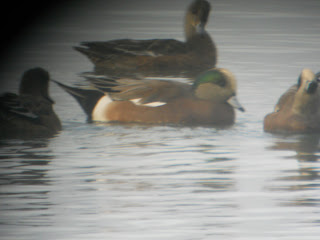In my November 1st posting of this blog, called "Fall Migration at Semiahmoo", I talked about Canada Geese. There are all-year, resident Canada Geese in coastal Washington and British Columbia, but there are also migratory Canada Geese. Can you tell the difference? Those that migrate to the Arctic are generally smaller...some nearly as small as Mallard Ducks. Our locals are very large, some weighing up to 11 kilograms/24 pounds.
Bathing, Preening Canada Geese at Semiahmoo
We do have geese and swans who reside here only in the late fall and winter, arriving with the cold arctic air. They are the Trumpeter Swans, the Snow Geese, and the Brants. With the first snow falls, I go looking for these waterfowl. The snow recently dusted the foothills and I headed for Skagit Valley.
New Snowfall in the Cascades above Bellingham
November 20
Snow Covered Maples near Maple Falls and Glacier
November 20
When the snow falls in the mountains and foothills and the frost covers the ground of my home in Bellingham, I look for geese and swans in the farmlands and wetlands of the Skagit Valley. You can often hear the geese before you see them, honking in flight, honking in the fields. There were small flocks in flight, joining flocks already resting on the plowed or fallow fields. Trumpeter Swans have often died when striking power lines. The local power company has taken to putting flag or tinsel-like objects on the lines to warn the swans. This has helped lower the number of fatalities.
Trumpeter Swans Flying Over Skagit Valley Farms
I saw a flock of Trumpeters numbering over one hundred in one field. I also looked for Tundra Swans. Tundra Swans also migrate between the north shore of Alaska and our coastal area. The Tundra Swan looks much like the Trumpeter Swan, but has a small, yellow spot in front of its eyes. I did not see Tundra Swans. The Trumpeter Swans, as can be seen in these photos, have heavy black markings in front of their eyes (the lores), joining with their black beaks. The yellow spot is absent.
Adult Trumpeter Swan
Gray Juvenile and White Adults
The Trumpeter Swans spend much of the winter grazing on the tender blades of grass in the plowed fields. In lakes they are dabblers, sticking their heads down into the mud for food. This has led to large die-offs, because they ingest lead shot in the mud, while rooting for vegetable matter. Lead shot is powerfully toxic to swans and geese. Laws have been enacted to change shotgun and bird shot shells from lead to steel, yet the old lead pellets lay in lake mud and in fields of heavily hunted areas. Efforts are being made to keep the Trumpeters from landing in lakes that were heavily impacted by lead shot. Locally, death-rates are dropping, but are still a major concern.
Birds have a preen gland at the upper base of their tail. In waterfowl, spreading the oil from this gland is important to 'waterproof' their feathers to help them float.
Trumpeter Swan Preening
The Skagit River runs through the farmlands of the Skagit Valley and forks into north and south branches, forming an island. This is where I saw between three and four thousand Snow Geese on November 19.
The South Fork of the Skagit River
I was amused to see that the Snow Geese were all in the posted 'No Hunting' area. They were absent from the surrounding farmlands. I have also visited the hunting areas in Skagit Valley and I have rarely seen a Snow Goose. Evidently, these geese have learned a few lessons.
Fir Island Reserve
Snow Geese at Fir Island
These two Snow Geese were showing their characteristic black primary feathers (wingtips) as they flew overhead.
Two Snow Geese in Flight
At least two thousand Snow Geese took flight within seconds, making a tremendous honking commotion. Something must have scared them. Bald Eagles often soar high over the valley, yet none were in sight (that I saw). There may well have been a raptor that I did not see. The geese flew, as if panicked, for at least a minute before landing.
Sudden Flight
Snow Geese fly in a loose V or U formation.
'U' Formation
Snow Geese Landing
Some calm Snow Geese took to the water. The adults are all white, except for their primaries. The younger geese show more grey mottling.
Snow Geese Floating on a Diked Drainage Canal
You might be wondering why there are no dark-bodied Snow Geese in these photos. Those with dark bodies and white necks and heads are called Blue Morph Snow Geese. They were not present in this flock.
White Morph Flock with their Pinkish Bills and Legs
At the beginning of this posting, I mentioned that a marine goose, the Brant, should be arriving from the Arctic. I went to the Padilla Bay Interpretive Center (a Natural History Museum/Education Center) and asked about the Brants. The person who had been given responsibility to note the arrival of the Brants had not yet seen them in Padilla Bay. Perhaps I will be able to report on the arrival of these small, sea-loving geese on a future posting of this blog.
Previous Postings of the Bellingham Field Journal:
1. Merlins and Reading Nature; October
2. Shorthand for Field Notes; October
3. Trees: A Key to Understanding Birds; October
4. Fall Migration at Semiahmoo & Birch Bay; November
5. Feather Forensics: Feathers Can Tell a Story; November
6. Urban Wildlife; November
























































